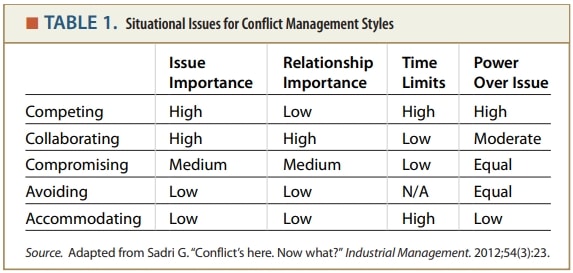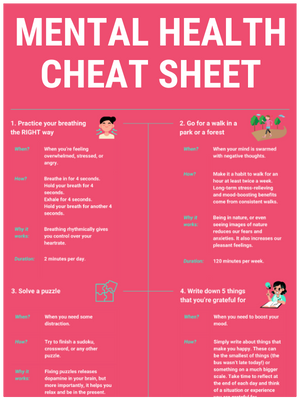“Speak when you are angry and you will make the best speech you will ever regret.” These wise words by Ambrose Bierce give us a good chuckle, but unfortunately, we so often forget to apply their wisdom to our daily interactions.
Conflict is everywhere in our lives. And yet, we are too often caught off guard, wholly unprepared, or plain terrible at dealing with it. Think about how much negativity you could avoid, relationships you could repair, and opportunities you could create if you gained the skills to handle conflict in a healthy way. Well, this is totally possible! If there’s one thing all conflict management researchers agree on, it’s that you can learn these skills.
That’s exactly what you’ll learn in this article. We’ll lay out all the steps, skills, and strategies for healthy conflict resolution. As always, our tips are all backed by research and experts. By the end, you can be confident to handle any strife or spat life may throw your way.
Contents
How to keep conflict healthy – 6 principles
What is the true cause of tension in conflict?
Many of us would think – logically – of the problem that is being argued about.
But researchers say something else: the way people manage conflict tends to cause more tension than the conflict itself.
That’s right – knowing how to approach the conflict has more benefits than actually solving the problem!
Research proposes several models to help us do that. We’ll discuss them below, but first, let’s have a look at the six principles that all these models have in common:
- Conflict is inevitable and it can have positive or negative consequences, depending on how you handle it.
- You will probably have much better results by actively dealing with conflict rather than avoiding it.
- People must be motivated to address conflict.
- You can learn all the behavioral, mental, and emotional skills needed to successfully manage conflict.
- Emotional skills require self-awareness.
- The environment for dealing with conflict must be neutral and safe.
What are the 5 conflict resolution strategies?
There are 5 common approaches to dealing with conflict.
Of course, by the time one arises, emotions are often too intense for you to pause and ponder which approach is best.
However, becoming aware of them is very helpful in two ways:
- You’ll gain self-awareness on how you typically react to conflict and in what situations. This allows you to understand your mistakes and how to improve on them.
- You can plan a strategy and be prepared to react in the right way in the future.
Let’s have a look at these 5 conflict resolution strategies.
1. Avoiding
Avoiding is equivalent to silence – you actively decide not to deal with the problem. Therefore, both your and the other person’s distress is ignored.
Who uses it:
Often people who are non-confrontational or not very self-confident.
How it is used:
You might think that it’s desperate and pointless to try to discuss the problem. As a result, you don’t bring up issues and remove yourself from situations that could lead to disagreements.
Advantages:
This might be a good choice in a few situations:
- When the issue is very small and not worth picking apart.
- As a temporary response to let you calm down and deal with it later.
- When other people could resolve the issue better than you.
Pitfalls:
You might develop a sense of unawareness of problems and feel less accountable for your actions.
2. Competing
The competing approach means being forceful, uncooperative, and assertive. You follow your own goals without caring about the goals of others.
Who uses it:
Normally only when a person holds some kind of power over the others involved. For example, a boss with their employees, or a parent with a young child.
How it is used:
You may use frustration, irritation, and open hostility to increase your authority. You can use that authority to remove conflicting people from the situation.
Advantages:
It may be a useful approach in emergency situations when decisions need to be made fast.
Pitfalls:
No final resolution is ever agreed upon. The outcome is a “win-lose” situation.
3. Accommodating
Accommodating, also known as yielding, means neglecting your own concerns to please others.
Who uses it:
People who choose this style often really want recognition and support from others. In other words, they want to fit in with the other person and get along well with them.
How it is used:
With this style, you might use apology or humor to end the disagreement and lighten the mood. You express your goal in an indirect way and avoid coming straight to the problem.
Advantages
This approach may be necessary for a few situations:
- When you are wrong.
- When the issue is more important to other people.
- When keeping positive relationships with the people involved is more important than the benefit of resolving the conflict your way.
Pitfalls:
If you over-use this style, you may eventually become depressed or resentful. You are always giving other people what they want at the expense of your own needs.
4. Compromise
With the compromising style, everyone involved tries to find a “common ground”. They realize that not everyone can be fully satisfied in every conflict. Thus, they are prepared to sacrifice some of their own needs to reach a resolution everyone can agree on.
Who uses it:
Usually people with equal power.
How it is used:
Compromise is a balance of assertiveness and cooperation. It’s usually a negotiation where you have a set amount of resources to fix a problem.
Advantages:
In this approach, everyone’s needs are at least partially met. People approach the problem with open-mindedness to the ideas and perspectives of others. This usually leads to good outcomes.
Pitfalls:
Over time, you may grow tired of always getting a little, but not everything you want.
5. Collaboration
Collaboration, also called cooperation, is the ultimate “win-win” scenario. Everyone works together to find a solution that everyone can be happy with. You’re just as concerned with the needs of others as your own. But at the same time, you’re not willing to give up what’s important to you just to soothe other people.
Who uses it:
This approach works when everyone involved feels mutual respect and trust.
Advantages:
This is the only approach that can work when people have to continue to work together after a conflict and maintain a good relationship. Innovative ideas often come up and everyone is happy with the outcome.
Pitfalls:
This approach can take up a huge amount of time.
What is the best approach to resolving conflict?
Above, we’ve seen the 5 common conflict resolution strategies. But how can you tell which one is the best for a given situation?
To answer that, you have to consider what’s most important to you.
Each of the 5 approaches can be defined by the importance they place on two things:
- the problem at hand.
- your relationship with the other person involved in the conflict.
It’s also helpful to consider the time you have to deal with the problem and the power you have over the issue. Just these things alone can sometimes determine which approach is even possible for you to use.
Sally Erin Howell offers this table as a clear overview:

4 steps for preparing to resolve conflict in a healthy way
Great conflict resolution starts with great preparation. Here are 4 crucial steps.
1. Ask yourself: do you even need to address this conflict?
If we had to deal with every conflictive situation that came up, we’d be caught in a constant argument.
Thankfully, we don’t have to – because not every problem is worth addressing.
How can you tell?
You must weigh the potential reward of the solution you want against the price of addressing the issue. This balance is unique to each situation.
For example, if your girlfriend snaps at you after a long, tiring day, it may not be worth quibbling over. You may get an apology out of her, but you’ll bring out negative feelings and potentially start a fight before you get there. If you just let this moment pass, her bad mood will pass too and you’ll both soon forget all about it.
On the other hand, what if it’s a pattern that happens often and is affecting your relationship? Making this stop is more important than the negative feelings caused by the discussion.
Here’s a general rule of thumb: if it is affecting your behavior or still bothering you, you should address it.
2. Analyze the nature, intensity, and underlying issues of the conflict
Once you decide you should address the conflict, the next step is to figure out what kind of conflict you’re dealing with. This is the foundation you need to figure out how best to handle it.
The nature of the conflict:
Before you can manage a conflict, you need to know what you even need to discuss.
Researchers offer some helpful guidance to figure this out:
- If the problem happens once, focus on the content of the issue.
- If it has happened repeatedly, focus on the pattern of events.
- If the problem affects your relationship with the other person, focus on the relationship.
The intensity of the conflict
It’s also helpful to consider the level of intensity of the issue. One model divides it into five levels:
- Differences: people have different perspectives on the situation, but they understand the other person’s viewpoint and are comfortable with the difference.
- Misunderstandings: people understand the situation differently. These can be common and minor, but they can also escalate when stakes are high. If they are frequent, there is probably a problem in communication.
- Disagreements: people have different viewpoints, but even though they understand the other person’s position they are uncomfortable with the difference. If disagreements are ignored they can easily escalate.
- Discord: people have issues with each other even after conflict is resolved. There is often constant tension in the relationship.
- Polarization: people feel intense negative feelings and there is little or no hope of resolution. This level of conflict needs to begin with an agreement to start communicating.
Deeper issues beneath the surface of the conflict
Also consider if there are any deeper issues beneath the surface. Many conflicts have, in fact, nearly nothing to do with what’s actually being fought about.
For example, if Derek and Jane have plans to go to dinner, but Derek cancels because he has to work late, they might get into a fight over this. On the surface, it may look like Jane is disappointed because Derek canceled their date. But beneath the surface, there may be one of several issues.
- Maybe Jane’s father was a workaholic who suffered from intense health problems. Jane is scared that the same will happen to Derek.
- Perhaps Jane feels like Derek doesn’t dedicate enough attention and care to her. Him canceling their date is just one more way he’s showing her that she’s not his priority.
- Jane might be feeling insecure in the relationship. She’s worried that Derek is becoming too close to the pretty new coworker he’s working with.
As you can see, these issues could be nearly anything. It’s crucial to identify them. If not, even if you resolve a conflict, you haven’t really gotten to the matter at hand. It will keep bubbling up until you do.
Work to identify your own underlying issues before trying to handle the conflict. During the discussion, ask questions to dig up the other person’s underlying issues as well.
3. Prepare yourself to deal with the conflict
To address a conflict successfully, we need to understand our own position, mentality, and desires. Though it seems trivial, this kind of introspection is one of the most crucial conflict resolution skills.
Research suggests that answering these questions can be extremely helpful:
- Do you have all the information necessary to discuss the conflict? Is there anything you’re simply assuming and don’t know for sure?
- What exactly do you hope to gain from the confrontation? Is this conditional on anything?
- What are you prepared to give up or compromise?
- What outcomes do you want to avoid?
- What are your emotional responses or “triggers” to this issue? How might these affect your view of the situation or your reactions during the conversation?
- What fears do you have about the outcome of the conflict?
- Are you ignoring your own role in the problem?
- What are your own motivations and goals for resolving this conflict?
With the last question, it’s also good to consider the motivations and goals of the other person. Anger can make us jump to all sorts of conclusions about their intentions.
- “They wanted to make me look like a fool!”
- “They don’t have any respect for me at all!”
- “They’re just plain stupid and unreasonable!”
But is this really the case? Consider why a rational and ethical person would have behaved in a way that upset you.
Let your emotions cool down
If you’re having trouble answering the questions above, you will struggle even more to discuss the conflict. In this case, postpone the discussion until you can think more calmly and clearly.
Be aware of issues with mindset
You need to be able to go into a conflict without having an “us versus them” mentality. Remember, the problem is not the other person, but the situation – and both of you need to work together to fix it.
Also be aware that everyone has biases – in fact, the biggest bias is “but I’m not biased!” Go into the discussion with an open mind. You don’t need to be right about everything to reach a happy resolution.
4. Establish a safe environment
Now we’re getting ready to discuss the conflict – but where and when will this happen? Deciding this may be more important than you think.
All research confirms that choosing a safe environment is paramount to healthy conflict resolution.
In essence, this means having a private, neutral setting and enough time to discuss the issue at hand. But this is only the logistics. Even more important is how each person treats the others.
A safe environment means everyone believes they will be respected and treated fairly. In particular, researchers identify three types of necessary trust:
- Trust of character: confidence in the intention of others
- Trust of disclosures: confidence that people will share information, be honest, and keep private information confidential
- Trust in capability: confidence in others’ abilities to deliver on promises
A safe environment also requires mutual respect and mutual purpose:
- Respect involves using appropriate tone of voice, words, and facial expressions.
- Purpose means having a common goal.
Agreeing on a mutual purpose may be a good way to start a conflict resolution conversation. It may also help guide the conversation in the right direction, and help you both realize if you go off track.
How to resolve conflict – conducting the conversation
With your preparation done and a safe environment chosen, it’s time to begin the discussion.
This part is difficult to plan. Even if you plan everything you want to say, they will always say something unexpected that will derail your entire script.
However, there are a few strategies and guidelines it’s good to keep in mind. They will help you guide both the conversation and your own behavior towards a successful resolution.
We’ve divided them into the 5 conflict resolution steps below.
5. Establish a mutual understanding of the conflict
A good way to start the discussion may be to gain a mutual understanding of the issue at hand. This will let you avoid worsening it through misunderstandings or assumptions.
One organization calls this first phase “scoping”. It includes:
- A mutual understanding of what is happening
- Both your and the other person’s perspective of the conflict
- What is important to both you and the other person
- Ways you can both work towards a solution
If you are in a formal environment, such as at work, you should also outline the ground rules about confidentiality and decision making.
6. Let each person say their point of view and feelings
Next, each person should be allowed to say their perspective and opinion.
The author of Crucial Conversations offers an excellent 3-step model on how to share your own side of the story without being conflictive (Chapter 7).
1. Share your facts
Start by sharing the objective facts that led to the thoughts and feelings you had. What did you see or hear that led you to come to certain conclusions? Facts are things that other people cannot dispute, such as “Yesterday you arrived at work twenty minutes late” or “There is a charge on our credit card bill for $300 from the Good Night Motel”. Keep feelings and conclusions out of this first part.
2. Tell your story
Of course, the facts are not what caused the conflict – it’s the story we tell ourselves about them. “You’re lazy and don’t care about your work”, or “My husband is having an affair”, for example. But remember, this is only your story – it’s not the confirmed truth. By the end of a successful discussion, you’ll find out if it is or isn’t true – but to do that, you need to avoid making the other person defensive and let them share their own perspective.
Explain the impression you got and the conclusions you came to. Try to phrase it as only a possible story and use tentative language like this:
- “I was wondering why..”,
- “I was wondering why…”
- “It looks like”
- “In my opinion”
- “Maybe” / “Perhaps”
3. Ask for others’ paths
After you share your story, you should ask others to share their views – and mean it. Ask yourself, “Is my boss really intending to micromanage me?” To find out the answer, you have to encourage the other person to express their facts, stories, and feelings, and carefully listen.
You also need to phrase your invitation in a way that makes it clear that no matter how controversial their ideas might be, you want to hear them. Phrases like these are very helpful:
- What am I missing here?
- I’d really like to hear the other side of this story.
- Does anyone see it differently?
A healthy conflict resolution example
Here is an example of these three steps from Crucial Conversations (Chapter 7):
Brian: Since I started work here, you’ve asked to meet with me twice a day. That’s more than with anyone else. You have also asked me to pass all of my ideas by you before I include them in a project. [the facts]
Fernando: What’s your point?
Brian: I’m not sure that you’re intending to send this message, but I’m beginning to wonder if you don’t trust me. Maybe you think I’m not up to the job or that I’ll get you into trouble. Is that what’s going on? [The possible story + invitation for another path]
If you’d like to review this model in more detail, Crucial Conversations is full of more examples, tips, and insights.
7. Listen actively while each person is speaking to gain a better understanding
You’ve now had your say – but here comes the hard part. Listening openly to everyone else.
Listening is an absolutely crucial conflict resolution skill. Yet many people “listen” only to respond. As someone is talking, they are already formulating counter-arguments and fidgeting until it’s their turn again.
But if you truly want to resolve a conflict, you need to be able to let go of your own view of the situation. You’ll temporarily step into the thoughts and feelings of the other person. They think and feel the way they do for a reason – what is it? What precisely did they notice and why did they interpret it the way they did?
If their perspective on the situation is pushing your buttons, remember these principles:
- Just because they say something, doesn’t automatically make it true.
- Just because you haven’t said something yet, doesn’t mean it’s not true.
- The truth will not change, regardless of anything anyone says.
So there is no harm in letting someone voice even an absurd or completely off-base opinion. Besides, it’s true at least in their minds – and you need to understand why so that you can fix the issue.
As each person is explaining their point of view, you should ask clarifying questions without imposing your own view of the situation. This is a skill that requires practice. You must be aware of your tone and volume of voice to make sure the environment stays respectful.
You might like to use the AMPP acronym to help you listen well in the discussion:
AMPP acronym for the four listening skills
• Ask – especially open-ended questions.
• Mirror – make observations (e.g. you seem down today) then ask a question.
• Paraphrase – restate their responses in your own words to confirm that you’re listening and clarify if you’ve understood.
• Prime (helpful if they’re reluctant to talk) – with a calm tone, guess what they might be thinking or feeling and let them confirm or correct you.
8. Define the problem
Through respectful sharing of your side, and active listening to the other side, you should be able to define the problem. You need to all agree on what the problem is to be able to compare and discuss solutions.
If you’d like more concrete examples and advice, Thanks for the Feedback explains in detail how to recognize and define a problem whenever you have to resolve a conflict with someone.
9. Brainstorm solutions and decide on one
With the problem defined, you can begin to brainstorm possible solutions to it. Ideally, these should address the needs of everyone involved.
Next, each person can discuss their preferred solution. If the ideal solution requires resources like time and money, you should do a “reality check” to make sure it is feasible.
10. Define an action plan (in formal settings)
Once you have agreed on a solution, you may like to create an action plan, depending on your environment. It should outline the “who, what, and when” of fixing the problem. If you do make one, make sure everyone understands their role and tasks.
💡 By the way: If you want to start feeling better and more productive, I’ve condensed the information of 100’s of our articles into a 10-step mental health cheat sheet here. 👇
This Cheat Sheet Will Help You Be Happier and More Productive
Thrive under stress and crush your goals with these 10 unique tips for your mental health.
Wrapping up
As you probably already know, conflict resolution is no easy task – but with the tips and insights above, it’s certainly possible to become better at it. Though none of us look forward to conflict, I hope you can at least approach your next one with a greater sense of clarity, purpose, and confidence.
When was the last time you had to resolve a conflict? Are you happy how you dealth with the situation? I’d love to hear from you in the comments below!


